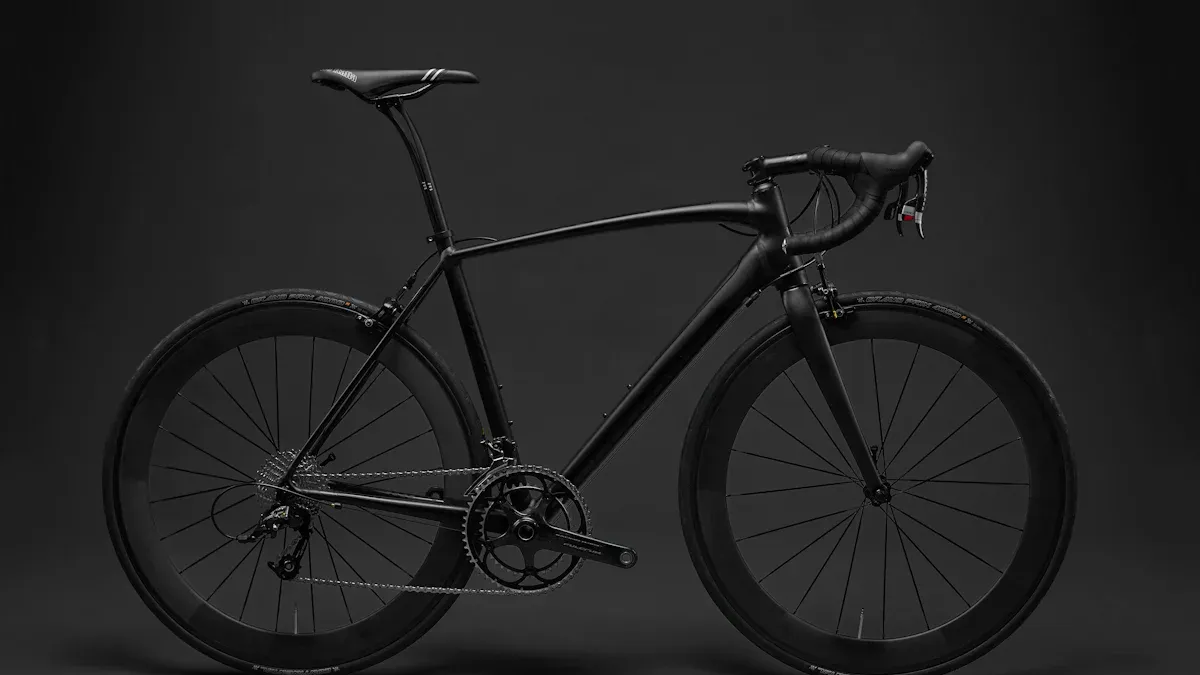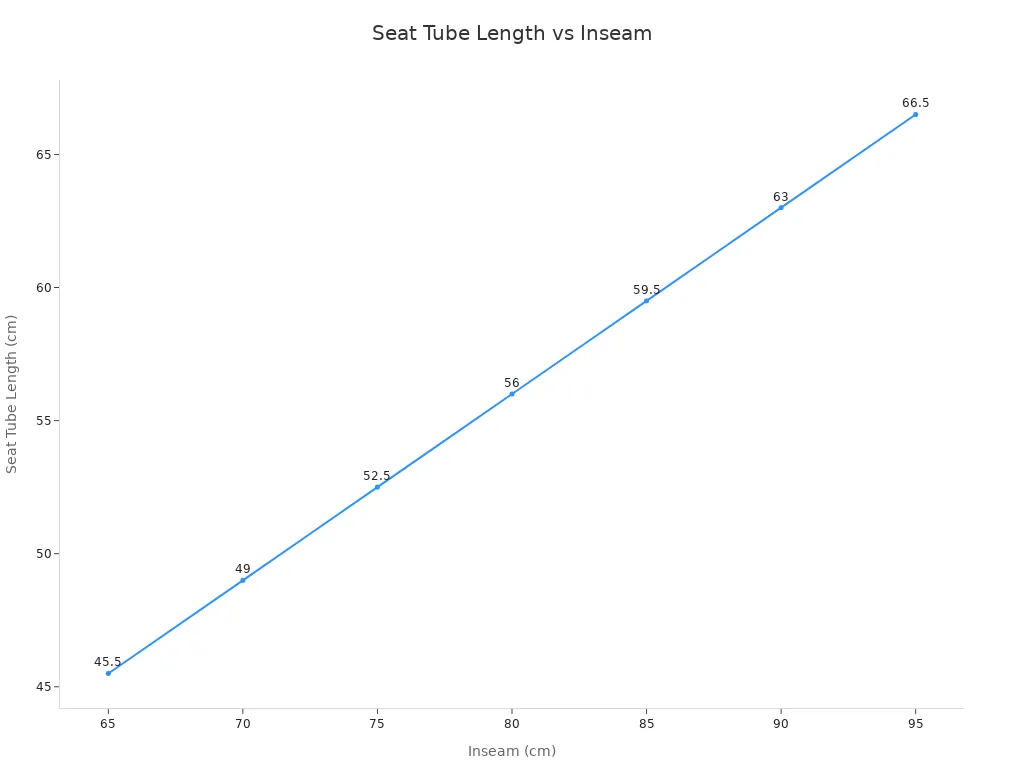
A bike frame size chart helps you pick the right bike for your body. When you use a bike size chart, you match your height and inseam with the frame measurements like seat tube length and reach. This simple step makes a big difference—almost 80% of cyclists ride bikes that don’t fit, which can cause back pain or knee strain. You just need to measure your inseam and height, and you’ll see how bike sizing can boost your comfort and safety. Always check the bike frame size chart for your bike type to make sure you get the best fit.
Key Takeaways
Use a book and tape measure to check your inseam and height. This helps you find the right bike size.
Pick the right bike frame size chart for your bike type. Make sure it matches your measurements.
Pay more attention to inseam length than height. Inseam length shows how the bike fits your legs and saddle.
Look at the bike’s standover height for safety and comfort. Make sure you have enough space when you stand over the bike.
Change your saddle and handlebars after picking the right size. This helps you feel comfortable and ride better.
Why Bike Frame Size Matters
Comfort and Safety
When you ride a bike that fits your body, you feel comfortable and safe. The right bike frame size helps you keep good posture and avoid pain. If you ignore bike fitting, you might notice pain in your lower back or neck. Sometimes, your wrists or hands hurt because the handlebars do not match your reach. You may even find your shoes hitting the front wheel when you turn. These problems often mean the frame does not fit your height or inseam.
Tip: A professional bike fitting can help you find the perfect fit and avoid these issues.
Here are some common problems caused by the wrong bike frame size:
Lower back and neck pain from poor posture
Awkward handlebar and wrist positions
Trouble getting full leg extension
Needing to push the saddle too far forward or back
Discomfort from shoes hitting the front wheel
When you focus on fitting the bike to your body, you can ride longer without pain. You also lower your risk of injury. Always check your height and inseam before choosing a frame. This step makes bike fitting much easier and safer.
Performance and Riding Style
The right bike frame size does more than keep you comfortable. It also helps you ride better. When you match your height and riding style to the frame, you use your muscles more efficiently. Studies show that changing the seat tube angle or handlebar height can boost your power and reduce muscle fatigue. This means you can ride faster and farther with less effort.
Your riding style also affects which frame size fits best. Take a look at this table:
Riding Style | Frame Size Preference | Why It Matters |
|---|---|---|
Aggressive/Pro | Smaller | Lower handlebars for speed and control |
City/Stop-and-Go | Smaller | Easier to handle and quick to maneuver |
Touring/Comfort | Larger | More upright, stretched position for long rides |
If you like fast rides or racing, a smaller frame lets you get low and aerodynamic. For city riding, a smaller frame helps you stop and turn quickly. If you want comfort on long trips, a larger frame gives you a relaxed fit. Adjusting the seatpost or handlebars can help fine-tune the fitting, but starting with the right bike frame size is key.
Remember: Fitting the bike to your height and riding style makes every ride smoother and more fun.
Measure Your Inseam and Height

Getting the right bike fit starts with knowing what should you measure. When you want to properly size and fit a bike, inseam is the most important number. Height helps, but inseam length tells you how your legs will reach the pedals and the ground. If you only use rider height, you might end up with a bike that feels too tall or too short. Leg inseam gives you the best chance for a comfortable ride.
Tools Needed
Before you start measuring your inseam and height, gather a few simple tools. You do not need anything fancy. Here is what should you measure with:
A hardcover book (or a thick, flat object)
A tape measure (metric or inches)
A flat wall and hard floor
Cycling shoes (if you have them)
A friend or family member to help (optional, but makes it easier)
Tip: Measuring your inseam while wearing cycling shoes gives you a more accurate fit. The extra thickness of the shoe sole changes your leg inseam and affects saddle height. If you skip the shoes, your measurements might be off by a few millimeters.
Step-by-Step Guide
Let’s walk through how to measure your inseam and height for bike fitting. Take your time and double-check your numbers for the best results.
How to Measure Your Inseam
Stand with your back against a flat wall. Place your feet about 6 to 8 inches apart.
Wear your cycling shoes if you have them. If not, go barefoot or wear thin socks.
Put on cycling shorts or tight pants. Bulky clothes can mess up your leg inseam measurement.
Take a hardcover book and place it between your legs. Pull it up firmly into your crotch, just like a bike saddle would. Make sure the book is level and touches the wall.
Have a friend help you measure from the floor to the top edge of the book’s spine. This is your inseam length. Write down the number in centimeters or inches.
Repeat the process two or three times. Use the largest number as your final inseam. This helps you get the most accurate fit.
Note: The book method works better than a yardstick alone. The book simulates saddle pressure and helps you find your true leg inseam. Some bike shops use a thick dowel and a level, but the book is easy and reliable at home.
How to Measure Your Height
Stand tall with your back and heels against the wall.
Look straight ahead and keep your chin level.
Place a flat object (like another book) on top of your head, making sure it is level.
Mark the spot where the bottom of the book touches the wall.
Use your tape measure to check the distance from the floor to the mark. This is your total body height.
Why Inseam Matters More Than Height
You might wonder why everyone talks about inseam so much. Here’s the reason: leg inseam tells you how high your saddle should be and how much clearance you have over the top tube. Height can be tricky because people have different leg and torso lengths. Two riders with the same height might have very different leg inseam numbers. That’s why measuring your inseam is the best way to fit a bike.
When you use your inseam length, you can match it to the bike’s frame size for a perfect fit. This helps you avoid knee pain, back pain, and awkward riding positions. If you only use height, you might end up with a bike that does not fit your body.
Pro Tip: Online tools like the Wrench Science Fit System or the Specialized Retül app can help you double-check your measurements. These tools use your inseam and height to suggest the best frame size for your riding style.
Quick Reference Table
What Should You Measure? | Why It Matters for Bike Fitting |
|---|---|
Leg inseam | Sets saddle height and standover height |
Height | Helps confirm frame size range |
Remember, measuring your inseam and height is the first step to a great bike fit. Take your time, use the right tools, and always double-check your numbers. This way, you will feel confident when you use a bike frame size chart to pick your new ride.
Use a Bike Frame Size Chart
When you want to find the right bike, a bike frame size chart is your best friend. These charts help you match your height and inseam to the correct frame size for your body. But not all bikes use the same chart. Road, mountain, and hybrid bikes each have their own sizing systems. If you use the wrong chart, you might end up with a bike that feels awkward or uncomfortable.
Choose the Right Bike Size
You need to start by picking the right chart for your bike type. Road bikes, mountain bikes, and hybrid bikes all use different sizing systems. Road bikes usually use centimeters and show frame size as a number, like 54 or 56. Mountain bikes often use inches or size labels like S, M, or L. Hybrid bikes mostly use S/M/L, but sometimes you see inches too.
Here’s a table to help you see the differences:
Bike Type | Sizing System | Size Labels | Measurement Units | Height Range (approx.) | Inseam Range (approx.) | Additional Notes |
|---|---|---|---|---|---|---|
Road Bikes | Centimeters (cm) | Numeric (e.g., 47-62) | cm (seat tube length) | 152 cm (4’11”) to 195 cm (6’4″) | 71 cm to 92 cm | Sizing up for long arms, sizing down for stiffer, lighter bike or upright position |
Mountain Bikes | Inches or S/M/L hierarchy | XS to XXL (e.g., 13.5″ to 23″) | Inches and S/M/L labels | 137 cm (4’5″) to 203 cm (6’7″) | 64 cm to 95 cm | Wheel size suggestions included (26″, 27.5″, 29″) |
Hybrid Bikes | Mostly S/M/L system | S to XXL | Mostly S/M/L, some inches | 155 cm (5’1″) to 203 cm (6’7″) | 72 cm to 95 cm | Choose larger size for longer limbs or larger wheels, smaller size for mobility issues |
You can see that each bike type covers a different range of height and inseam. Always check the bike size chart for your specific bike type before you choose the right bike size.
Tip: Never guess your size based on wheel size. For adults, wheel size does not tell you what size of bike is right for me. Focus on frame size, height, and inseam instead.
What Size of Bike Is Right for Me
Now you have your height and inseam measurements. The next step is to match them to the bike frame size chart. Most charts use your leg inseam to find the best frame size. This is because the seat tube length should fit your inseam closely. If the frame is too big or too small, you will feel it right away.
There is a direct link between your inseam and the seat tube length. Many charts use a simple formula for road bikes:Leg inseam (cm) x 0.7 = frame size (cm)
For example, if your leg inseam is 80 cm, your ideal frame size is about 56 cm. This method works well for road bikes. Mountain and hybrid bikes use similar ideas, but the numbers change a bit.

When you look at a bike frame size chart, always match your inseam first. Height is helpful, but leg inseam gives you a better fit. If you fall between two sizes, think about your riding style. If you like a more upright ride, pick the smaller frame. If you want to stretch out or have longer arms, go for the larger one.
Note: Bike frame size charts can be different from one brand to another. A size 56 from one company might not fit like a size 56 from another. Always check the chart for the brand you want.
Some common mistakes people make with a bike size chart include:
Picking a frame based only on height, not inseam.
Using the wrong chart for the bike type.
Ignoring brand differences in frame size.
Forgetting to check reach and stack if you have long or short arms.
Not trying the bike in person if possible.
If you ever wonder, “What size of bike is right for me?” remember to use your inseam, check the correct chart, and think about your riding style. If you are still unsure, visit a local bike shop. They can help you test ride and adjust the bike for the best fit.
Pro Tip: Professional bike fitters use special tools and even motion capture to find your perfect fit. They look at more than just height and inseam. They check your reach, flexibility, and riding goals. But for most riders, a good bike frame size chart and careful measuring will get you very close to the correct frame size.
Using a bike frame size chart is the best way to choose the right bike size for your body. Take your time, measure carefully, and always double-check the chart for your bike type. This way, you will ride in comfort and enjoy every mile.
Check for a Right-Sized Bike

Standover Height
You want to make sure you can straddle a bike comfortably before you ride away. The best way to check this is by looking at the bike standover height. Stand with your feet flat on the ground and lift the bike so the top tube is right under you. There should be at least 1 to 2 inches (about 2 to 5 cm) of space between your crotch and the top tube for most bikes. For mountain bikes, you need even more clearance—up to 3 inches—because you might need to jump off quickly on rough trails. This space helps you stop safely and keeps you from getting hurt if you slip off the pedals.
Here’s a quick table to show how standover height affects your ride:
Standover Clearance | Comfort Level | Safety | Control |
|---|---|---|---|
1-2 inches (ideal) | High | High | Great |
Less than 1 inch | Medium | Medium | Okay |
No clearance | Low | Low | Poor |
When you have the right clearance, you feel balanced and ready for anything. If you don’t, you might feel cramped or even risk injury. Always check this before you pick the right-sized bike.
Adjust for Comfort
After you find the right bike size, you still need to fit your bike to your body. Start by adjusting the saddle height so your leg is almost straight when the pedal is at the bottom. Move the saddle forward or back until your knee lines up with the pedal axle. Make sure the saddle is level or just a little tilted forward. Next, set the handlebar height and angle so your back feels relaxed and your hands rest easily.
Here are some steps to help you fit your bike:
Adjust the saddle height for proper leg extension.
Move the saddle forward or back for knee alignment.
Level the saddle for comfort.
Raise or lower the handlebars to match your style.
Try different handlebar angles for the best grip.
You should always test ride the bike after making changes. Listen to your body. If you feel pain or numbness, stop and adjust again. Sometimes, you need to test ride the bike more than once to get the perfect bike fit.
Keep in mind, every bike brand has its own frame shapes and sizes. Geometry like reach, stack, and tube angles can change how a bike fits, even if the size number looks the same. If you switch brands, always check the fit again.
If you ride more often, change your riding style, or notice discomfort, adjust your bike fit. Regular checks help you stay comfortable and safe on every ride.
Choosing the right bike size is simple when you follow these steps:
Measure your height and inseam with a tape measure and a book.
Use the correct size chart for your bike type.
Check standover height and adjust for comfort.
Compare Stack and Reach if you are between sizes.
Think about your riding goals and posture.
If you feel unsure, local bike shops and professional fitters can help you test and fine-tune your fit. A well-fitted bike keeps you comfortable, helps prevent injuries, and makes every ride more fun. 🚴♂️ Enjoy your new bike and ride with confidence!
FAQ
What if I fall between two bike frame sizes?
If you fall between sizes, think about your riding style. Want a relaxed ride? Go smaller. Like to stretch out or have long arms? Try the bigger size. Test both if you can.
Can I use my height alone to pick a bike size?
You should not use height alone. Your inseam gives a better fit. Two people with the same height can have different leg lengths. Always measure both for the best results.
Do all bike brands use the same size chart?
No, brands use different charts and frame shapes. A size medium in one brand might feel different in another. Always check the chart for the brand you want.
How do I know if my bike is too big or too small?
If you struggle to touch the ground or feel stretched out, your bike might be too big. If your knees hit the handlebars or you feel cramped, it could be too small. Listen to your body.
See Also
Exploring The Science Powering Carbon Fiber Bicycle Frames
How Carbon Fiber Enhances The Smoothness And Lightness Of Cycling
